The LG V60 and VELVET Review: A Classic & A Design Restart
by Andrei Frumusanu on July 15, 2020 9:00 AM ESTDisplay Measurement - Typical LG
We mentioned that we have a high suspicion that the V60 and Velvet screen panels are identical, even though there’s a different shape cover glass over both. One further difference between the two phones is their software calibration. The V60 comes with LG’s classic wide range of display profiles (Auto, Cinema, Sports, Game, Photos, Web, Expert) that we’ve seen introduced over the last few years, whilst the Velvet has more significantly simplified things down to only three presents as a custom option (Natural, Vivid, Cinema, Custom).
For the V60, LG’s most accurate preset which actually targets an sRGB gamut is the “Web” profile and that’s what we tested here today. On the Velvet, it unfortunately looks like LG dumbed things down a little too much, as the phone no longer has any profile that’s able to target an sRGB gamut, with all of the available presets targeting some larger colour spaces. We’ve left it on the “Natural” mode as it gave a good enough white-point out of the box.
We move on to the display calibration and fundamental display measurements of the V60 and Velvet screens. As always, we thank X-Rite and SpecraCal, as our measurements are performed with an X-Rite i1Pro 2 spectrophotometer, with the exception of black levels which are measured with an i1Display Pro colorimeter. Data is collected and examined using Portrait Display's CalMAN software.

In terms of brightness, the new LG panels here don’t fare all too well in terms of their maximum brightness. In manual mode, both phones do get brighter than what we typical see of Android OLED devices at around 485 cd/m², but the auto mode under bright environments doesn’t raise this figure much at all, only reaching 525-550 cd/m² on both phones. The auto mode does change the colours and improves contrast for legibility, but can’t really compete with the newer generation Samsung AMOLED panels in terms of brightness.

 Portrait Displays CalMAN
Portrait Displays CalMAN
LG V60
Moving on onto greyscale testing, the LG V60 has some large problems in terms of properly tracking a correct gamma curve. The mid-levels are far too dark, beyond reasonable error rates. The good news is that the colour balance and temperature on the phone is quite good and reaching whites and average colour temperatures of 6600K – a little bit cooler over the 6500K natural sunlight white target, but I prefer this to say Samsung’s usual too warm colour tones.
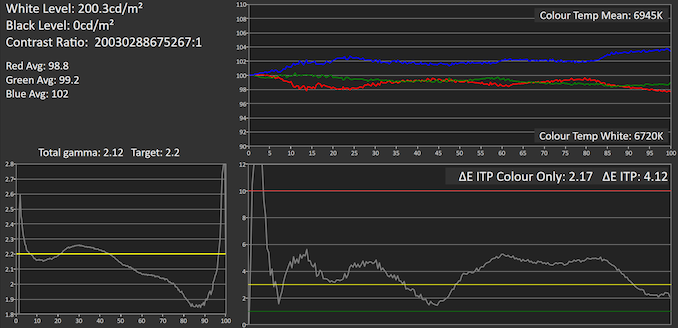
 Portrait Displays CalMAN
Portrait Displays CalMAN
LG Velvet
The LG Velvet’s greyscale results also have issues with the gamma tracking, but this time around it’s on the upper levels where it’s showcasing too low gamma, resulting in tones being brighter than they should be. The Natural colour profile here is also more noticeably cooler, with an average colour temperature of 6945K. It’s possible to fine-tune the colour temperature in the custom settings to alleviate this if it’s a bother.
In the saturations against an sRGB gamut, we see the LG V60 fare quite well when it comes to just the colours themselves. The phone’s biggest issue here is the aforementioned handling of the gamma, resulting in the tones being far too dark.
On the Velvet, as the phone doesn’t actually have a native accurate sRGB mode, it means that all the targets here are way off mark as the “Natural” gamut doesn’t correspond to any particular colour space. This also isn’t a P3 target as the blue hue is significantly different in hue – I don’t know precisely what LG is targeting here if they’re even targeting any standard at all.
In the GMB test with common test tones and colours, the V60 falls flat on its face as the results are outright disastrous. This isn’t too much of a surprise as LG has a long history of making a complete mess of their display colour calibrations in their phones, and the V60 is unfortunately just a continuation of that tradition.
The Velvet, oddly enough, actually fares quite well in the GMB test even though it really shouldn’t be given its non-sRGB gamut. The biggest noticeable difference in the comparison palette is that many of the patches are brighter than they should be, which again points out to the lower than should-be gamut calibration.
Overall, both phones are very clearly LG phones and their colour calibrations are amongst the worst in the market right now. The V60 in particular has just atrocious results given that this was supposed to be an accurate “Web” profile targeting the sRGB space. It’s really unfortunate what the company did here, but after so many years of seeing repeated disaster after disaster, I’ve just come to accept that LG phones simply won’t ever have accurate colours, as sad as that sounds.


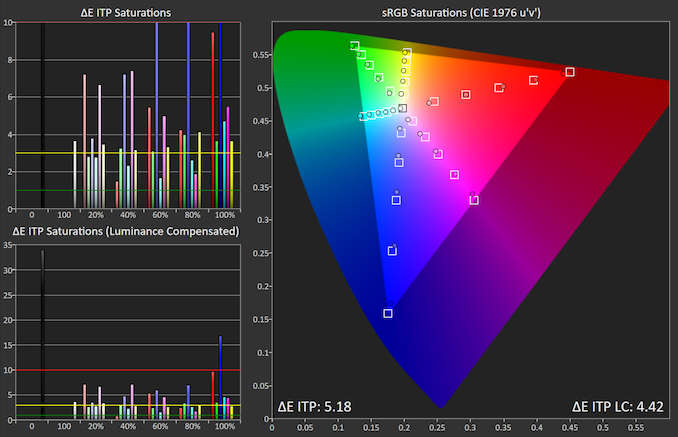
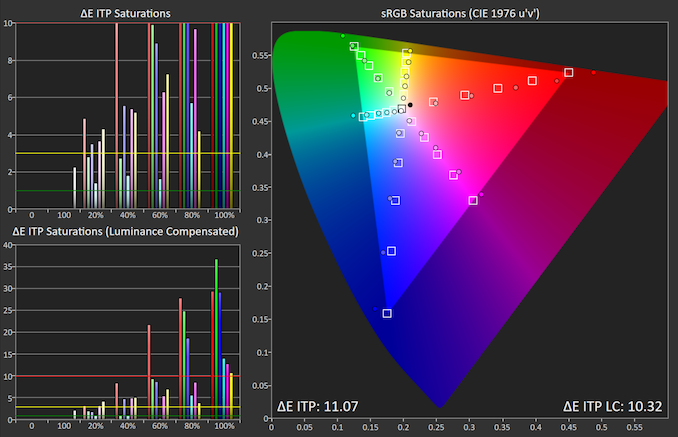
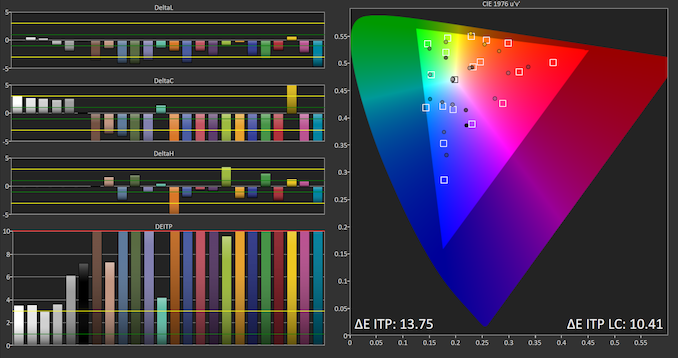

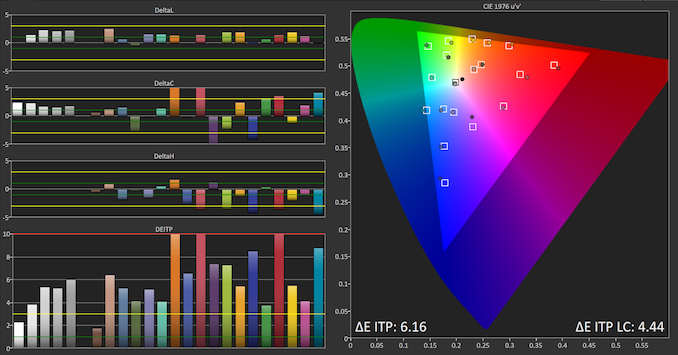









81 Comments
View All Comments
philehidiot - Wednesday, July 15, 2020 - link
Myself, it's a matter of price. For £400 more than my current SIM only package (over 24 months) I can get an S10. That's a VERY hard deal to beat. I'm currently paying £2.50 a month more than if I got on a decent 24 month contract as I've been awaiting the 5G rollout to upgrade, so I'm on a monthly contract with unlimited data. So any phone has to be available at £400 or less before even consideration as the S10 is the benchmark.flyingpants265 - Sunday, July 19, 2020 - link
Not a fan of S10's curved screen edges. Still annoying.What I needed was OP7, Samsung, or LG G4/G8, or Realme X.. with blackshark style front speakers, and no other missing features.
flyingpants265 - Monday, July 20, 2020 - link
Well... True, honestly.I'm no fan of LG, their phones are defective. And I want a phone with front speakers.
But this looks like a OP8 with headphone jack. Or S10 with no stupid curved screen.
The second Samsung, LG or OnePlus make a flagship phone with front stereo speakers, I'll be all over it.
peevee - Friday, July 24, 2020 - link
Agree on the useless pixels. Either the people are near-sighted and don't use glasses when looking at the screens, or just go by "bigger is better" attitude of self-delusion (claiming the see the difference without a double blind test).PeachNCream - Wednesday, July 15, 2020 - link
That's a lot of money to pay for a phone with a battery that isn't easily replaced. Kind of a pity since it doesn't really help make phones better in some meaningful way by stopping the user from yanking out and installing a fresh battery after it starts to get tired less than a year later.TheinsanegamerN - Wednesday, July 15, 2020 - link
Agreed, although with a capacity and runtime like that "tired in less then a year" doesnt apply. It isnt 2005 anymore.after 4 years my moto z play still has great battery life and is only just now starting to falter. Even so I agree on the price, no way I'd pay $900 for a phone.
PeachNCream - Wednesday, July 15, 2020 - link
It's probably more of a symptom of the phones that I end up using, but I do find myself on an annual-ish replacement cycle for batteries regardless of the design and that means keeping a small set of specialized tools plus rolling the dice with replacement batteries. That is present day experience though rather than one from fifteen years ago when, in fact, my cell phone battery retained its endurance for quite a bit longer due mainly to the fact that it was necessary to charge the battery once a week or so rather than daily.TheinsanegamerN - Wednesday, July 15, 2020 - link
My work gives us iPhones. While 3-4 hours runtime is the norm for them, I never had one lose appreciable battery life after less then 3 years outside of the 6s’ faulty one.My personal phones have been a moto z play and before that a note 4 with a 10,000 mah zero lemon battery. The moto is showing signs of wear after nearly 4 years, the note never showed signs of wear. Before that was a dumb phone that went many years on the original battery.
TheinsanegamerN - Wednesday, July 15, 2020 - link
I should note all my personal phones went at least 3 days on a charge when new, with the dumb phone pasting 2 weeks and the note lasting 7-8 days. The moto z play goes 3-4, but I was forced to upgrade, Id’ve stuck with the note 4 if I could.PeachNCream - Friday, July 17, 2020 - link
If I leave my phone alone, it will generally sit idle for close to four days without requiring a recharge. That is a rare thing though since I tend to put my phone to use doing just about everything I used to do on my computer. Mine tends to be busy most of the day with web activity, e-mail, lengthy writing (always working on the next novel), watching videos, streaming radio or running local music, playing a few games - mainly emulators of 8- and 16-bit consoles but sometimes a few native Android games as well so I rarely end the day without charging. Since lockdown and staying at home became a thing, I've just let my phone connected to a charger almost constantly and that's been nice.Brings me back to the point though. I usually see well over a 30% drop in battery life over the course of a year and that's annoying enough to warrant an annual replacement which is never fun thanks to spudgers, tiny hex screws and so on. It isn't the most tedious thing I get to do, but it would be a LOT better to simply make the battery removable.